Havarti Cheese: Discover the Creamy Delight of This Dairy Treasure!
Havarti cheese is a semi-soft, mild-flavored Danish cheese. It has won the hearts and taste buds of cheese lovers worldwide. Originating in Denmark, it boasts a creamy, buttery texture. Its versatile flavor makes it a favorite for many dishes.
Table of Contents
What is Havarti ?
Havarti is a semi-soft, washed-rind cheese from Denmark. It’s known for its mild, buttery, and nutty flavors. Its smooth, creamy texture makes it perfect for melting.
A Brief History of Havarti
Havarti started in the late 19th century by Danish cheesemaker Hanne Nielsen. It was named after Havarthigaard, where it was first made. Today, is loved globally, a favorite among cheese lovers.
The Unique Flavor Profile
Havarti cheese is famous for its mild, buttery taste with a nutty hint. Its creamy texture melts well, making it great for many dishes.
“Havarti cheese is a true Danish delight, with a flavor that is both comforting and captivating.”
Enjoyed alone or in dishes, havarti offers a wonderful taste experience. It has a big following worldwide.

Havarti Cheese Nutrition Data
Havarti cheese is not only tasty but also good for you. It’s a semi-soft cheese packed with vitamins, minerals, and macronutrients. These nutrients help keep your diet balanced and healthy.
A single 1-ounce (28-gram) serving of Havarti cheese has about:
- 110 calories
- 9 grams of fat
- 7 grams of protein
- 20% of the recommended daily intake of calcium
| Nutrient | Amount per 1 oz (28g) Serving | % Daily Value* |
|---|---|---|
| Calories | 110 | – |
| Total Fat | 9g | 14% |
| Saturated Fat | 6g | 30% |
| Cholesterol | 30mg | 10% |
| Sodium | 180mg | 8% |
| Total Carbohydrates | 0g | 0% |
| Protein | 7g | 14% |
| Calcium | 200mg | 20% |
These facts show how great havarti cheese is. It’s a tasty and healthy choice for those looking for a good dairy option.

The Origin of Havarti Cheese
Havarti has a rich history that started in the late 19th century in Denmark. It was first made by Danish cheesemaker Hanne Nielsen at the Havarthigaard farm. She perfected a recipe that made Havarti a favorite cheese worldwide.
From Denmark to the World
Havarti’s origins: The Havarti’s popularity spread over Denmark and was adored by its flavor and its versatility. Today, it’s manufactured in Canada, the United States, Canada, and a variety of European countries. This means that Havarti’s legacy will live in the future.
The history behind Havarti is a testament to its beauty and quality. It is now a standard in many homes and is a favourite among foodies and chefs.
The story of Havarti’s origin is one of innovation and the past. From Denmark all over the world, Havarti has found a unique place in the history of cheese. It is a delight to the palate and is a source of inspiration for cooking all over the world.
What Does Havarti Taste Like?
Havarti is known for its buttery taste. It has a delicate, slightly nutty flavor that’s creamy and mellow. Its smooth texture makes it a favorite for many dishes.
Exploring the Buttery Essence
The making of havarti is special. It’s mild yet flavorful, with a hint of sweetness. Enjoy it on its own, in a sandwich, or in a recipe, and you’ll love its taste.
Havarti’s buttery taste and creamy texture are perfect for many dishes. It works well in grilled cheese, pasta, and even desserts. Its flavor is a joy to experience.
“Havarti’s mild, buttery flavor pairs beautifully with both sweet and savory elements, making it a truly versatile cheese.”
If you love cheese or want to try something new, Havarti is great. Its creamy and subtle taste shows the skill of Danish cheese makers.
Havarti Cheese Varieties
The traditional havarti is well-known, but there are many unique varieties. These specialty havarti options can make dishes more interesting. They work well in everything from appetizers to main courses.
Dill, Jalapeño, and More
Dill Havarti is a favorite, with a fresh dill taste. It’s great on sandwiches, crackers, or as a snack. Jalapeño Havarti adds a mild heat, perfect for tacos, burgers, or grilled cheese.
- Dill Havarti: Infused with fresh dill for a bright, herbal flavor
- Jalapeño Havarti: Features a subtle spicy kick for a touch of heat
- Smoked Havarti: Offers a rich, smoky profile that complements a variety of dishes
- Caraway Havarti: Blends the nutty, earthy essence of caraway seeds into the classic Havarti cheese
These havarti cheese varieties show how versatile this cheese is. They let home cooks and chefs try new flavors and improve their dishes.
Does Havarti Melt Well?
Yes, Havarti is known for its great melting. It’s semi-soft and buttery, perfect for dishes needing a smooth texture. Its mild taste and softness make it great for grilled cheese and casseroles.
Havarti’s melting secret is its softness. It has more moisture and less fat than hard cheeses. This lets it melt smoothly, without getting stringy or oily.
When melted, Havarti turns creamy and velvety. It adds richness to dishes and pairs well with many flavors. This makes it a go-to for cooking and baking.
“Havarti cheese melts beautifully, creating a rich, indulgent texture that elevates any dish.”
For grilled cheese, mac and cheese, or casseroles, Havarti is a top pick. It melts well, adding a creamy touch to your dishes.
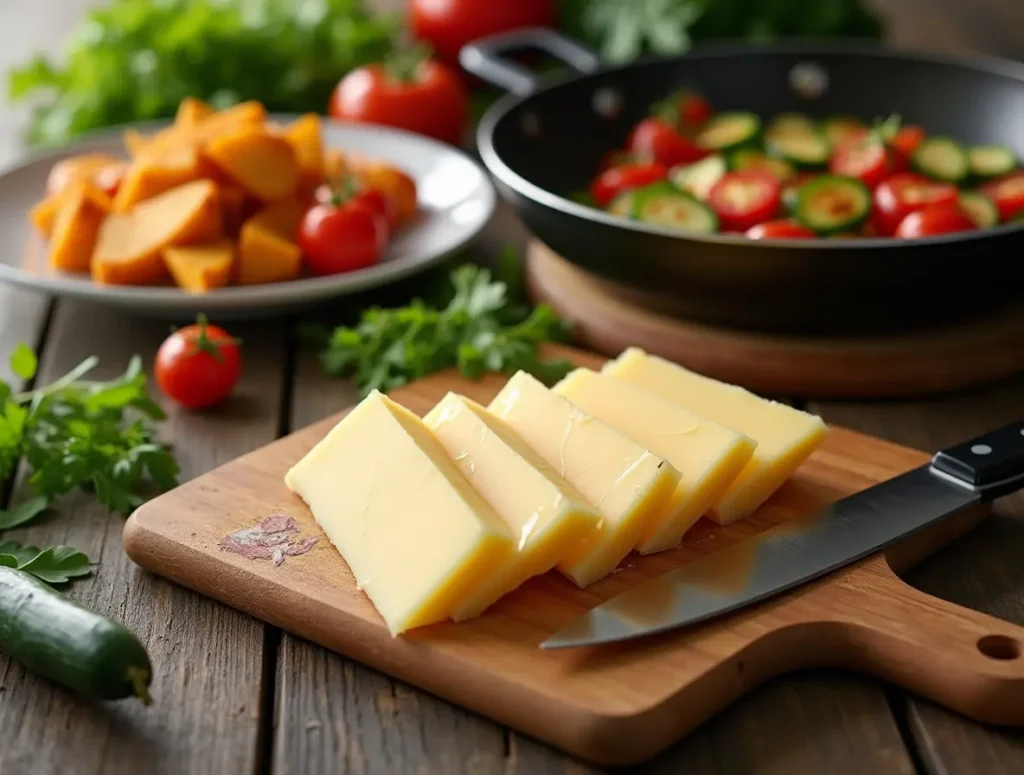
Havarti in Cooking
Havarti cheese is a versatile and flavorful ingredient. It can make many dishes better. Its creamy texture and mild, buttery taste are loved by many.
Recipes and Serving Suggestions
Havarti in cooking is great in grilled cheese sandwiches. It melts nicely creating a sandwich that is soft and delicious. It’s also great with cheese and macaroni and cheese, adding a creamy flavor.
Havarti cheese can be used in a variety of baked products and casseroles. Its mild taste works with both sweet and savory ingredients. It’s wonderful for frittatas, quiches and baked desserts such as turnovers and tarts.
Try cutting havarti cheese to create a simple but elegant cheese platter. Serve it alongside dried fruits, cured meats and crackers. Its buttery taste is a favorite with many.
Keep in mind that cooking using the havarti is a good idea since it melts easily. Serve it as a topping for pizzas, burgers and baked potato. Its melting power makes food tasty and satiating.
“Havarti cheese is a versatile and flavorful ingredient that can elevate a wide range of culinary dishes.”
If you are making comforting grill cheese or trying new baking recipes, havarti is a great choice. It adds creaminess, flavor, and texture to your dishes.
Pairing Havarti with Wine and Beer
When it comes to pairing havarti, the options are endless. This creamy, mild-flavored cheese pairs beautifully with a variety of beverages. From crisp white wines to hoppy craft beers, it’s a great match.
For a classic wine pairing, try serving havarti alongside a glass of Sauvignon Blanc or Chardonnay. The cheese’s buttery notes complement the bright acidity and fruity flavors of these white wines. This creates a harmonious flavor combination.
But havarti isn’t just for wine enthusiasts. Its creamy texture and subtle flavors also make it an excellent companion to many craft beers. The cheese’s buttery essence pairs particularly well with the hoppy bitterness found in IPAs and other hop-forward brews. This creates a delightful balance of flavors.
Whether you’re hosting a wine tasting or a beer and cheese pairing event, havarti is a versatile option that is sure to please. Its mild flavor profile allows it to complement a wide range of beverage pairings. This makes it a go-to choice for any cheese lover.
Havarti vs. Other Cheeses
Havarti is different from other semi-soft cheeses. It has a unique taste and texture. Compared to cheddar or Swiss, havarti is milder, with a buttery, slightly nutty flavor.
Its smooth, creamy texture is also unique. This makes havarti great for many dishes. It’s perfect for sandwiches, grilled cheese, baked goods, and charcuterie boards.
Comparing Flavors and Textures
To understand havarti cheese better, let’s compare it to other cheeses:
| Cheese | Flavor Profile | Texture |
|---|---|---|
| Havarti | Mild, buttery, slightly nutty | Smooth, creamy |
| Cheddar | Sharp, tangy | Firm, granular |
| Swiss | Nutty, slightly sweet | Firm, slightly grainy |
The table shows havarti is different. Its flavor and texture make it versatile for many dishes.
“Havarti cheese is a real standout in the dairy case, with its buttery, slightly nutty taste and creamy, smooth texture.”
Storing and Serving Havarti Cheese
Maintaining the havarti fresh is essential to enjoy its delicious texture and taste. It’s crucial to treat this cheese with care.
To keep Havarti fresh, keep it in the refrigerator. It is wrapped in wax paper, or put it in an airtight container. This prevents dryness and loosing its creamy flavor. Allow the Havarti get to room temperature prior to when eating it. This makes it more smooth and buttery and brings its full-bodied flavor.
Serving at the proper temperature is vital. It doesn’t matter if you’re enjoying it as a snack or incorporating it into the making of a recipe, or simply drinking it with beer or wine The proper care ensures it stays tasty. It’s a must-have Danish cheese is an absolute pleasure when stored and prepared properly.
| Storage Recommendations | Serving Tips |
|---|---|
| Refrigerate in wax paper or airtight container Avoid exposure to air to prevent drying Maintain ideal temperature and humidity levels | Allow to reach room temperature before serving Pair with complementary flavors and beverages Incorporate into recipes for optimal melting and texture |
“The key to enjoying havarti to the fullest is in the details of storage and serving. By following these simple guidelines, you can unlock the true essence of this beloved Danish delight.”
Conclusion
Havarti cheese is a true gem in the world of dairy delights. It has become popular worldwide, thanks to Denmark’s cheesemaking tradition. This versatile cheese is a must-have in any kitchen, whether you like the classic or its flavorful variations.
Havarti cheese is great in many dishes, from grilled cheese to baked casseroles. Its mild, slightly nutty flavor pairs well with wine and beer. As you try Havarti cheese, explore and enjoy how it can make your meals better.
Havarti is more than just a dairy product. It shows the art of cheesemaking and how traditions bring people together. Let Havarti cheese become a favorite in your kitchen and on your table.
FAQ
What is Havarti cheese?
Havarti cheese is a semi-soft, washed-rind cheese from Denmark. It’s known for its mild, buttery taste and creamy texture. This makes it great for melting.
What does Havarti cheese taste like?
Havarti cheese tastes mild and buttery, with hints of nuttiness or sweetness. Its smooth texture melts well, making it versatile in recipes.
What is the nutritional value of Havarti cheese?
A 1-ounce serving of Havarti cheese has about 110 calories. It contains 9 grams of fat, 7 grams of protein, and 20% of daily calcium.
Where does Havarti cheese come from?
Danish cheesemaker Hanne Nielsen created Havarti in the late 19th century. It’s now made worldwide, beyond Denmark.
Does Havarti cheese melt well?
Yes, Havarti cheese melts excellently. Its semi-soft texture and mild flavor make it perfect for melting in dishes.
What are some different varieties of Havarti cheese?
Besides traditional Havarti, there are Dill and Jalapeño varieties. They offer unique flavors and textures.
How can Havarti cheese be used in cooking?
Havarti cheese is versatile. It’s great in grilled cheese, mac and cheese, quiches, and casseroles. It’s also good sliced for cheese boards or as a topping.
What beverages pair well with Havarti cheese?
Havarti’s creamy flavor goes well with white wines like Sauvignon Blanc or Chardonnay. Craft beers also pair well.
How does Havarti cheese compare to other cheeses?
Havarti is milder than other semi-soft cheeses, with a buttery taste. Its creamy texture is different from the firmer textures of other cheeses.
How should Havarti cheese be stored and served?
Keep Havarti refrigerated, wrapped in wax paper or in an airtight container. Let it come to room temperature before serving. This enhances its creamy texture and flavor.

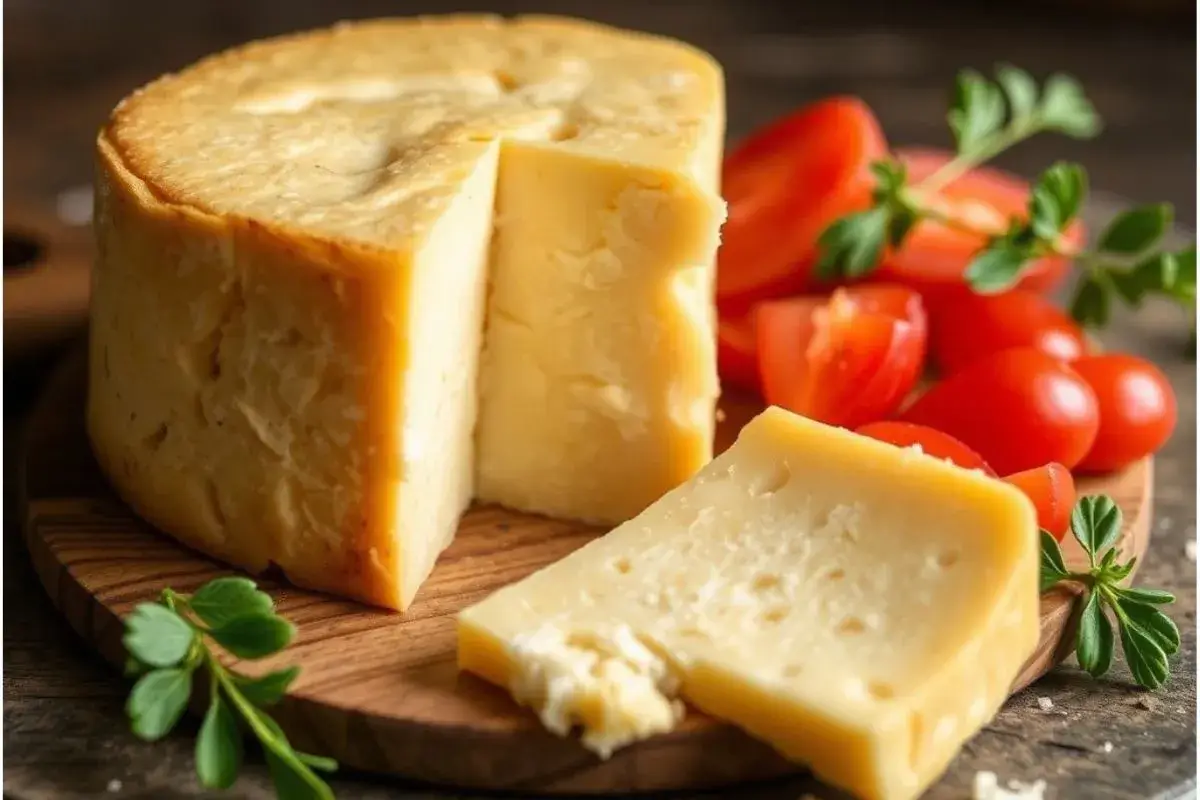

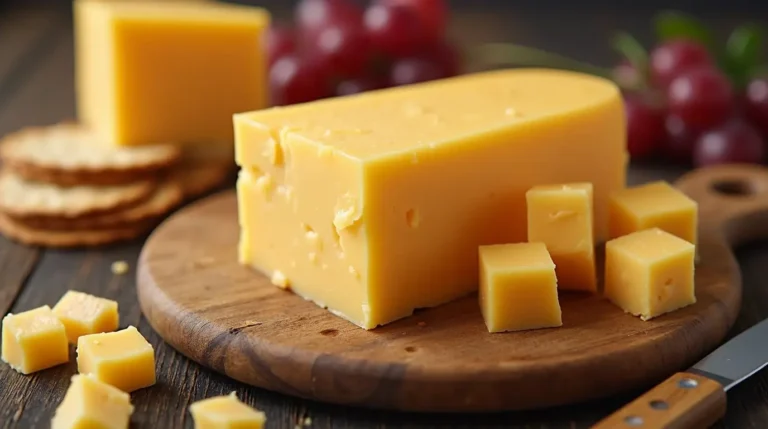
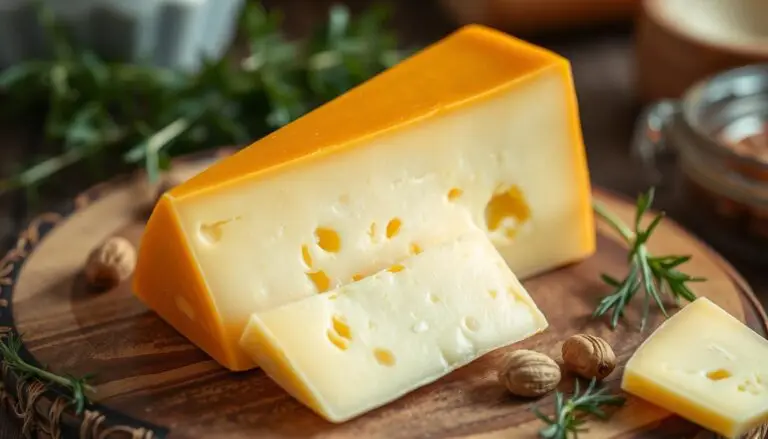
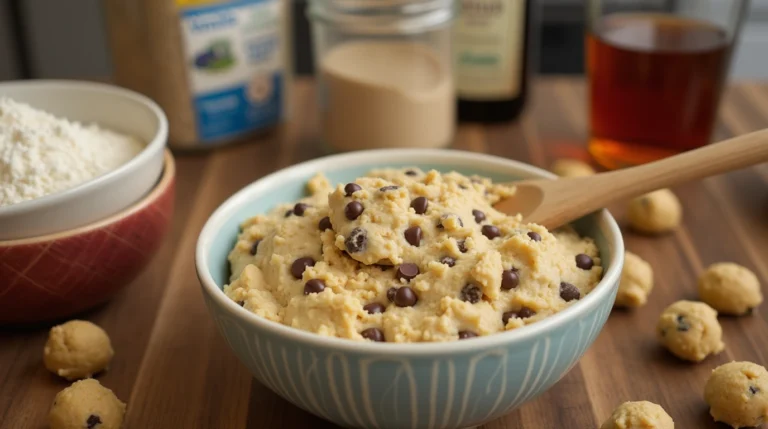
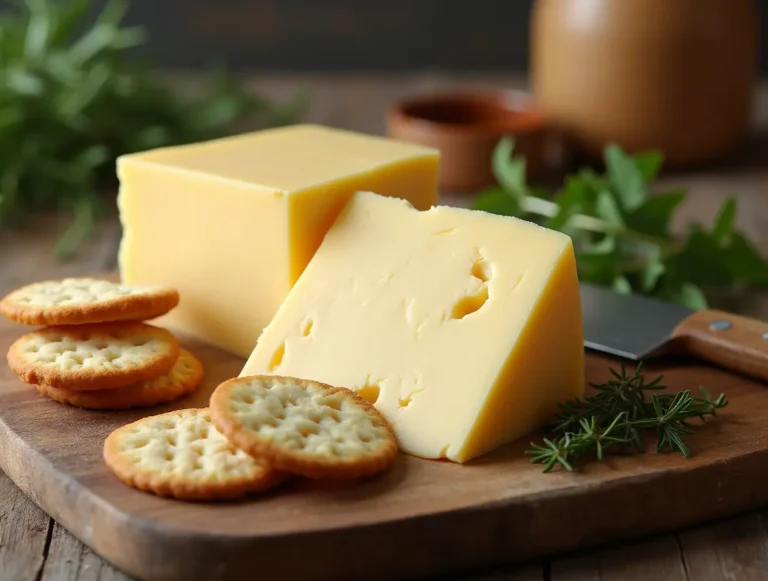
One Comment
Comments are closed.